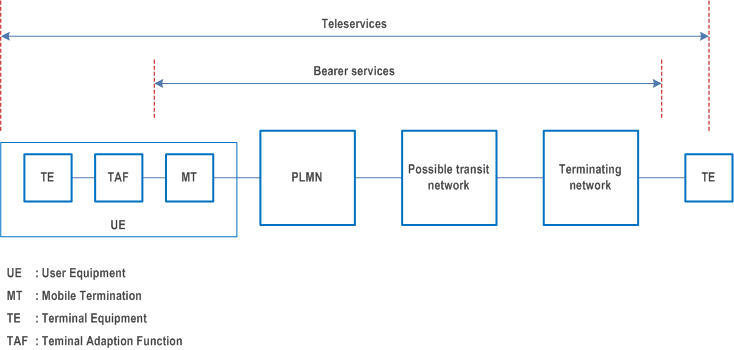Content for TS 22.105 Word version: 18.0.1
4 Framework for the description of telecommunication services and applications
4.1 General
4.2 Basic telecommunication services
4.3 Supplementary services
4.4 Service Capabilities
...
...
4 Framework for the description of telecommunication services and applications p. 8
4.1 General p. 8
Telecommunication services defined by 3GPP specifications are the communication capabilities made available to users by home environment and serving network. A PLMN provides, in co-operation with other networks, a set of network capabilities which are defined by standardised protocols and functions and enable telecommunication services to be offered to users.
A service provision by a HE/SN to a user may cover the whole or only part of the means required to fully support the service.
The service classification and description which follow are independent of different possible arrangements for the ownership and provision to the user of the means required to support a service.
4.2 Basic telecommunication services p. 9
Basic telecommunication services are divided in two broad categories;
- bearer services, which are telecommunication services providing the capability of transmission of signals between access points;
- teleservices, which are telecommunication services providing the complete capability, including terminal equipment functions, for communication between users according to protocols established by agreement between network operators.

4.2.1 Bearer services p. 9
The characterisation of a bearer service is made by using a set of characteristics that distinguishes it from other bearer services. Particular values are assigned to each characteristic when a given bearer service is described and defined.
The service characteristics as they apply at a given reference point where the user accesses the bearer service.
In the general case networks between the two access points use different control mechanisms. In this case the bearer services of each network throughout the communication link have to be translated at the network interfaces to realize an end to end bearer service.
A list of definitions of attributes and values used for bearer services is contained in clause 5.
The bearer services are negotiable and can be used flexibly by applications.
4.2.2 Teleservices p. 10
Section 6 defines both standardised and non-standardised teleservices. Some teleservices are standardised because that interworking with other systems have been recognised as a requirement. Other teleservices will not be standardised. A decoupling between lower layer (i.e. bearer attributes) and higher layer capabilities will be necessary for the development of teleservices.
4.3 Supplementary services p. 10
A supplementary service modifies or supplements a basic telecommunication service. Consequently, it cannot be offered to a user as a stand alone service. It shall be offered together or in association with a basic telecommunication service. The same supplementary service may be applicable to a number of basic telecommunication services.
Two methods are used for the characterisation of supplementary services;
- The first method is used for the description of existing standardised supplementary services. These services are specified through the detailing of each of the operations involved in service provision and service usage (the provision/withdrawal, registration/erasure, activation/deactivation, invocation and interrogation operations). Clause 7 lists these services.
- The second method enables the provision of HE/SN specific supplementary services. To make this possible, services can be built using service capability features which are accessed via the standardised application interface.
- Different phases of a call.
- A service spanning on more than one network.
- Service interactions that may occur between services offered to a single user, as well as between services offered to different interacting users.